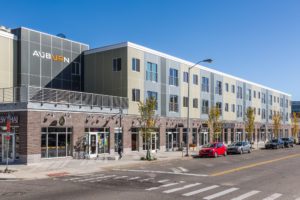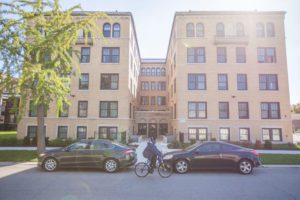By Ashlee Cunningham, Detroit Housing & Community Development Specialist
Long before Midtown Detroit—or Cass Corridor, as 39-year-old Wayne State University graduate and artist Rachel Barker prefers to call it—was booming with aesthetically pleasing coffee shops, hip art galleries and expensive retail stores, it was the neighborhood where Barker found the first apartment that she called home.
A Wayne State student at the time, Barker wanted to live in the area to be close to campus and focus on her education. She convinced her first landlord to let her sign a lease, despite not even having a full-time job to support paying rent. Along the way, she landed a job at MGM Grand Detroit, finished college, and fell in love with the neighborhood — most notably the communal feeling and energy it brought. She especially enjoyed getting to know the local business owners and artists.
As the years passed, Barker witnessed plenty of changes throughout the neighborhood—mainly an influx of new, younger residents. As more developments popped up, this trend continued—one echoed in cities across the nation. Between 2017 and 2018, commercial property values in Detroit rose 35 percent, and the majority of Detroit’s neighborhoods saw average residential property values increase between 10 percent and 20 percent in the same timeframe.
Stabilization vs. Gentrification

Since the Great Recession, several Detroit neighborhoods have seen investment, with mixed-use and multifamily buildings revitalizing communities.
Midtown has positioned itself at the heart of Detroit’s ongoing revitalization, through concerted efforts from local nonprofits, philanthropy, and government to decrease vacancy and spur the market in the city’s cultural core, which is both a neighborhood and a regional destination. It has become one of the city’s most desirable neighborhoods, with increasing rents and a stabilizing real estate market. The flip side of this positive outcome is that the area is also a prime target for resident displacement. In recognizing this trend, an opportunity presented itself to Midtown Detroit, Inc. and Capital Impact Partners to create a residential retention program that would lessen the housing burden on lower- and moderate-income Midtown residents. Thus Stay Midtown was launched.
The Growing Housing Crisis
Spending 30 percent or more of household income on housing is considered a cost burden, but across the country, more than 12 million Americans currently spend 50 percent or more of their income on it, according to the U.S. Department of Housing and Urban Development. This fact holds particularly true for Detroit—a city that faced widespread disinvestment following the decline of the automobile industry starting in the mid-19th century and most recently the Great Recession, leaving many of its lifelong residents without a steady means of income. Many of these residents have struggled to get back on their feet, even after the city has begun to emerge from its past economic adversity.

The decline of industry and financial crises took a great toll on Detroit. Affordable housing is a critical resource for residents experiencing economic hardship and allows community members to participate in the economic vibrancy of revitalizing areas.
Displacement of low- and moderate-income residents and families in urban areas throughout the country has an extremely negative effect on the long-term outcomes and prosperity for such residents. Families forced to relocate often move to less prosperous neighborhoods, which can perpetuate financial hardship and restrict economic mobility. It can also lead to stress and depression and can have a multitude of negative health impacts on children.
Companies and organizations have spent much of the past decade investing in Detroit in an effort to revitalize communities that have experienced long-term disinvestment. While investments are bringing some areas of the city back from the brink, concern exists around displacement of long-term community residents who must face rising housing costs along with unaffordable amenities and an overall increased cost of living.
Innovative Thinking for Equitable Communities
Stay Midtown was launched as a pilot program directly in response to findings from Capital Impact’s report—Baseline Study to Address Displacement and Relocation Tied to Multifamily Redevelopment in Greater Downtown Detroit. According to the report, in 2014, an estimated 45 percent of greater downtown renters experienced a housing cost burden, with black renters 1.4 times more likely to experience a burden than white renters. Capital Impact’s study of displacement and relocation in Detroit found that displacement of long-term residents was a trend likely to continue as market-rate housing replaced naturally occurring or subsidized affordable housing. According to the City of Detroit as many as 10,000 affordable housing units located in buildings with low-income housing tax credits could be lost in the next five years—putting thousands of residents at risk of displacement.

Creating space for residents, no matter their socioeconomic background, to share community deepens economic opportunity for all and keeps neighborhoods inclusive.
Maintaining affordable housing preserves the ability of low- to moderate-income residents to continue living and working in the city’s highest opportunity, highest access areas. Stay Midtown provides rental subsidies to current residents who earn between 30-80 percent of the Area Median Income. Since its inception in October 2016, Stay Midtown has enrolled more than 100 eligible households, helping them avoid displacement and retain affordable rental units in the Midtown area.
Keeping Longtime Residents in Their Homes
Feeling the pressure of displacement, along with many of her neighbors, Barker applied for the program. Barker is a true reflection of the impact that the program sought to make. The program has allowed her to continue to call the same Midtown apartment home for the past 18 years, despite all the change happening around her.
Barker’s mother and two of her close family friends have also benefitted from Stay Midtown, able to live affordably in Midtown and feel like they are a part of the revitalization happening in their neighborhood.
“I do not know where they’d be or where I’d be without Stay Midtown,” said Barker.

Providing rental assistance to longtime Detroit residents, who have seen the ups and downs, helps preserve the character of neighborhoods and expands equity and economic justice.
By offering both relocation and rental assistance for eligible residents, Stay Midtown aims to achieve its goal of preserving the neighborhood’s character. Based on the success of the program thus far, the hope is Stay Midtown can become a model that communities across the country can study and be inspired by in addressing the nationwide housing crisis.
Stabilizing Housing and Futures for Residents Nationwide
Innovative thinking is critical to preserving the livelihoods of individuals and families in communities that have experienced historical and systemic disinvestment. Investments in affordable housing provide a base from which communities thrive. Stay Midtown is just one example of Capital Impact’s investments in affordable housing for neighborhoods across the country.
As a fund manager of the Affordable Housing Preservation Fund in Washington, D.C., Capital Impact is preserving existing and creating new affordable housing for communities that have experienced historical disinvestment. Leveraging funding from the District’s Department of Housing and Community Development, Capital Impact is deploying $20 million in low-cost and flexible financing to private nonprofit and mission-driven for-profit developers combatting gentrification and rising housing costs by rehabilitating and building affordable housing in the city. In the San Francisco Bay Area, Capital Impact is partnering with community-based and philanthropic organizations to address the growing housing crisis in the region through the Partnership for the Bay’s Future. Through two breakthrough funds—the Investment Fund and Policy Fund—the Partnership aims to expand and protect the homes of up to 175,000 households over the next 5 years and preserve and produce more than 8,000 homes over the next 5 to 10 years.
Investments in these programs and initiatives helps remove barriers to success and empowers individuals and families to create the future that they want for themselves, communities with equitable futures full of opportunity.








